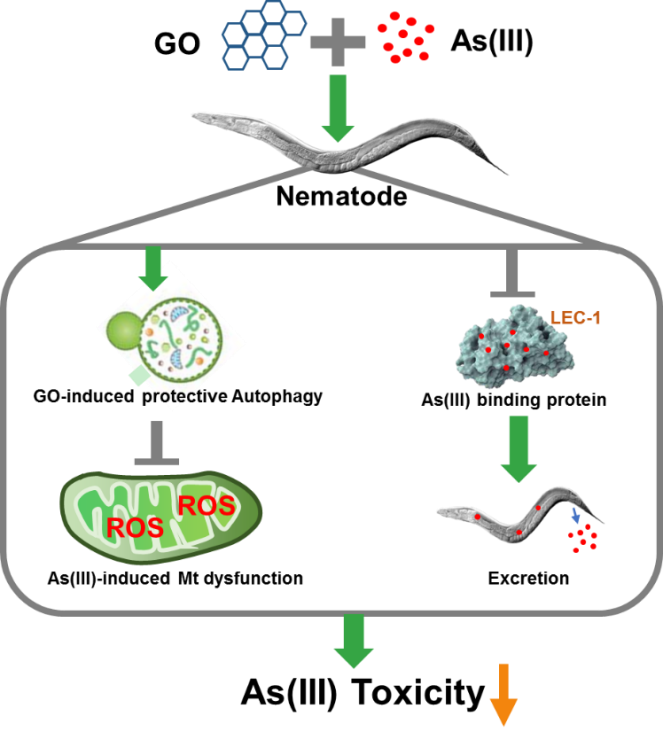Graphene oxide(GO) not only absorbed As(III), but also triggered protective “self-eating”, or autophagy, leading to an efficient inhibition of oxidative stress, a major contributing factor, in As(III) toxicity.
This mechanisms of GO in antagonizing the toxicity of environmental pollutants was revealed recently by Prof. XU An’s team in Institute of Technical Biology & Agriculture Engineering, Hefei Institutes of Physical Science.
GO, as a two-dimensional (2D) carbon-based nanomaterial, its superior physicochemical properties take the credit for applications in environmental protection.
Besides, owing to its low-cost, efficient, and environmental-friendly properties, GO has successfully attracted attention in fields of ecotoxicology and environmental health.
GO based nanomaterials have been applied for detect pollutants in the environment.
In addition, its extremely high surface area and abundant oxygenated functional groups confer it with an excellent capability to adsorb and remove organic and inorganic pollutants.
Thus, there is an urgent need to investigate the interaction of GO and pollutants, and explore the potential application of GO in pollutants detoxification.
In 2016, XU's team revealed GO has anantagonistic effect against the toxicity of 2,2,5,5-tetrachlorobiphenyl(PCB 52, an ortho-substituted, noncoplanar congener) mainly by triggering a genuine autophagic process.
Now, they took a closer look at the detoxification potential of GO to arsenic (As) in Caenorhabditis elegans (C. elegans) and discovered that GO, irrespective of pretreatment or concurrent treatment with As, significantly blocked the toxic response to As.
In addition to adsorbing As (III), GO was also demonstrated to trigger protective autophagy, leading to an efficient inhibition of oxidative stress and mitochondria dysfunction.
Using laser ablation inductively coupled plasma-mass spectrometer (LA-ICP-MS) and loss-of-function mutants, the data further showed that GO accelerate the excretion of As(III) from nematodes by suppressing the expression of As(III)-binding protein (Galectin-1, LEC-1).
This study might provide new insights into the potential application of GO in pollutants detoxification and environmental and health risk assessment.
This work was supported in part by grants from Major National Scientific Research Projects, Strategic Leading Science & Technology Program (B), National Natural Science Foundation of China and Major/Innovative Program of Development Foundation of Hefei Center for Physical Science and Technology.
Link to the paper: Graphene Oxide Antagonize Toxic Response to Arsenic via Activation of Protective Autophagy and Suppression of Arsenic-Binding Protein LEC-1 in Caenorhabditis elegans

GO antagonized the reproductive toxicity of As(III) (Image By DAI Hui)
Contact:
ZHOU Shu
Hefei Institutes of Physical Science (http://english.hf.cas.cn/)
Email: zhous@hfcas.ac.cn
 Tel: +86-551-65591206
Tel: +86-551-65591206
 Fax: +86-551-65591270
Fax: +86-551-65591270
 Emai: zhous@hfcas.ac.cn
Emai: zhous@hfcas.ac.cn
 350 Shushanhu Road
350 Shushanhu Road